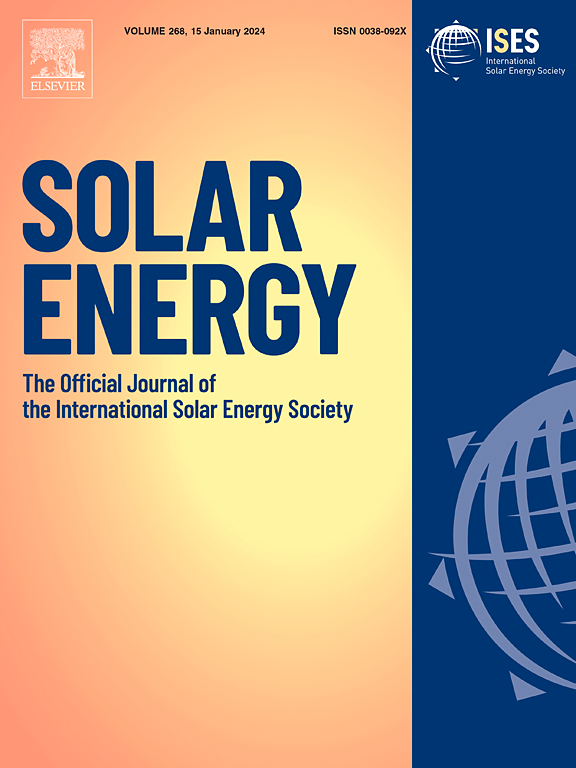Optimization and performance assessment of Ag@SiO2 core–shell nanofluids for spectral splitting PV/T system: Theoretical and experiment analysis
IF 6
2区 工程技术
Q2 ENERGY & FUELS
引用次数: 0
Abstract
Ag@SiO2 nanofluid is widely used in spectral splitting PV/T system. Its core–shell structure has great influence on the optical properties. In this work, we focus on the comprehensive analysis and structure optimization of Ag@SiO2 nanofluid to achieve its optimal spectral performance. DDA method is used to predict the optical properties of Ag@SiO2 nanofluid and an optimization model based on filter efficiency is proposed. The effect of the SiO2 shell thickness and Ag core mass concentration is analyzed. It indicates that the spectral performance of Ag@SiO2 nanofluid can be improved with SiO2 shell thickness of 15–40 nm and Ag core mass concentration of 81–135 mg/L. To achieve the same theoretical merit function of 1.46, the usage of Ag mass can be reduced by 25/33/44/62 % with SiO2 coating of 10/20/40/70 nm. The optimal structure to achieve the highest filter efficiency η of 37.8 % is with a shell thickness of 20 nm and a mass concentration of 113.9 mg/L. An indoor PV/T operation testing is conducted to verify the optimization results. The merit function of Ag-based nanofluids increases from 1.58 to 1.598 and a reduction in Ag usage of 17 % is achieved with a SiO2 coating shell of 17.8 nm. Operation stability is also enhanced with no aggregation observed during the working cycle and 7-day static experiment.
用于光谱分光光伏/发电系统的 Ag@SiO2 核壳纳米流体的优化和性能评估:理论与实验分析
Ag@SiO2 纳米流体被广泛应用于分光光伏发电系统。其核壳结构对光学性能有很大影响。在这项工作中,我们重点对Ag@SiO2纳米流体进行了综合分析和结构优化,以实现其最佳光谱性能。采用DDA方法预测了Ag@SiO2纳米流体的光学特性,并提出了基于滤波效率的优化模型。分析了 SiO2 外壳厚度和 Ag 核质量浓度的影响。结果表明,当 SiO2 外壳厚度为 15-40 nm,Ag 核质量浓度为 81-135 mg/L 时,Ag@SiO2 纳米流体的光谱性能可以得到改善。为了达到相同的理论功函数 1.46,SiO2 涂层厚度为 10/20/40/70 nm 时,Ag 的用量可减少 25/33/44/62%。壳厚度为 20 nm,质量浓度为 113.9 mg/L,是实现最高过滤效率 η 37.8 % 的最佳结构。为验证优化结果,进行了室内 PV/T 运行测试。银基纳米流体的优点函数从 1.58 增加到 1.598,二氧化硅涂层外壳厚度为 17.8 nm 时,银的用量减少了 17%。运行稳定性也得到了提高,在工作周期和 7 天静态实验中均未观察到聚集现象。
本文章由计算机程序翻译,如有差异,请以英文原文为准。
求助全文
约1分钟内获得全文
求助全文
来源期刊

Solar Energy
工程技术-能源与燃料
CiteScore
13.90
自引率
9.00%
发文量
0
审稿时长
47 days
期刊介绍:
Solar Energy welcomes manuscripts presenting information not previously published in journals on any aspect of solar energy research, development, application, measurement or policy. The term "solar energy" in this context includes the indirect uses such as wind energy and biomass
文献相关原料
公司名称
产品信息
阿拉丁
Ag nanoparticles
阿拉丁
ethanol (C2H6O)
阿拉丁
dimethylamine
阿拉丁
tetraethyl silicate
阿拉丁
sodium citrate (C6H5Na3O7·2H2O)
阿拉丁
dextrose monohydrate
阿拉丁
ammonia
阿拉丁
silver nitrate solution
阿拉丁
deionized water (DI)
 求助内容:
求助内容: 应助结果提醒方式:
应助结果提醒方式:


